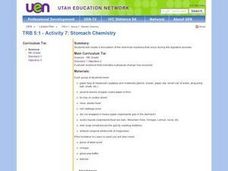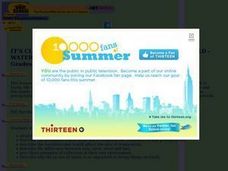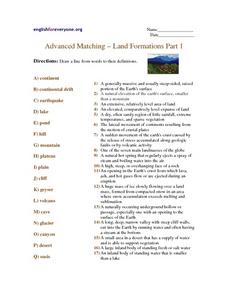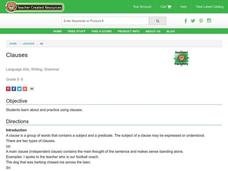Curated OER
Making a Comet in the Classroom
Students study comets and how Halley's comet was created. In this space lesson students create their own comets using dry ice.
Curated OER
The Chemistry of Bigger Bubbles
Fourth graders explore properties of bubbles. In this lesson about bubbles, 4th graders perform an experiment. Students analyze the properties of bubble making substances and surface tension. Students create a square bubble. Students...
International Technology Education Association
Pixel This!
Did the image I drew match the image you saw? By simulating a satellite and a ground station, teams of two transmit data in the form of pixels in order to recreate an image. They use four different levels of brightness, creating slightly...
Curated OER
Acid and Base Activities
Students experiment with acids and bases. In this elementary level chemistry lesson, students perform activities for testing acids and bases. They use universal indicator paper to determine which substances are acidic and which are...
Curated OER
Wet-Dry Bulb Hygrometers: Measuring Relative Humidity and Apparent Temperature
Young scholars work in groups of 4 for the activity/activity part of this exercise. They know that clouds are formed by the condensation of water vapor, affect weather and climate. Also that global patterns of atmospheric movement...
Curated OER
Comets and Meteors
Students construct a model of a comet nucleus using dry ice. They add other materials and describe the features. They complete related exercises on an Internet Web site.
Polar Trec
Do Microorganisms Live in Antarctica?
Can microorganisms live in the dry, cold climate of Antarctica? Young scientists view a research project measuring microorganisms in the Taylor Glacier. They record the findings from dirty ice, clean ice, boots, sediment, and more. Then...
Curated OER
Weather Challenge
For this identifying the weather terms activity, students read phrases about the weather and choose the term being described. Students choose 11 multiple choice answers.
Curated OER
Changing Planet: Sea Levels Rising
Begin by showing a six-minute video, Changing Planet: Rising Sea Level as an anticipatory set. Pupils draw a topographic map of a potato continent. Finally, they will visit NOAA's sea levels online map and NASA's carbon dioxide...
Curated OER
Dew and Frost
In this dew and frost worksheet, students complete an activity including water, ice cubes, rock salt and more to see the difference between dew and frost. Students also answer 3 questions.
Curated OER
Gingerbread Houses
Students use their knowledge of fractions and ratios to build gingerbread houses. In this fractions and ratios lesson plan, students use graham crackers, milk cartons, icing, and more.
Curated OER
Subsistence Calendar
Students create a subsistence calendar for seasonal activities in their community. In this seasonal activities lesson plan, students research the four seasons in their community and write down the activities to do in that season.
Curated OER
Kids in the Kitchen
Young chefs choose from a variety of ingredients to prepare a snack. Using soft peeled fruit, juice, crushed ice, sugar, dried fruit, dry ceral and nuts, learners experiment and make their own concoctions. This lesson would be especially...
Curated OER
Seashore Explorers
There are three separate lessons within this resource that can be used together, or that can each stand alone. In the first, five simple activities allow junior scientists to examine the amazing properties of water. In the second, they...
Curated OER
Symmetrical Snowflakes
First graders, exploring lines of symmetry, follow directions to create a symmetrical snowflake from their own homemade icing. As a class, they discuss lines of symmetry and determine if specific shapes are symmetrical. After the lesson,...
Curated OER
Physical Changes and States of Matter
Fourth graders identify a physical change as one that results in a change in size, shape, or state of matter. After an initial teacher-led discussion and demonstration, groups of students get together to perform an experiment which...
Curated OER
What is a Gas?
Young scholars develop a scientific model of gas behavior. In this gas lesson plan, students observe different balloons filled with different densities of gases. They complete an activity where they model the behavior of gases using...
Curated OER
Stomach Chemistry
Fifth graders compare physical and chemical changes. They perform a simulation experiment/activity that replicates what happens in the stomach as food is digested by stomach acids.
Science Friday
Capturing Carbon Dioxide
Why don't we just capture carbon dioxide in the air and store it somewhere else? A hands-on instructional activity allows scholars to explore a complex concept. First, they will create a carbonated beverage, and then they...
Curated OER
States of Matter Lessons
Teachers can give their students hands-on ways to explore solids, liquids, and gases with these lesson plans.
Curated OER
It's Clean, Fresh and only Three Billion Years Old - Water!
Students engage in a lesson which explores the wate cycle. They get to see some very entertaining video, do fun hands-on activities and gain a better understanding of evaporation, condensation, precipitation and collection.
Curated OER
Mystery : Structure of the Atom-A Case for Indirect Evidence
Students investigate the structure of the atom through hands on activities. In this atomic structure lesson, students perform 4 activities showing indirect evidence of the structure of the atom and the parts of the atom. They also list...
Curated OER
Advanced Matching--Land Formations Part 1
Using this activity, learners could review information they have covered about land forms, such as hills, mountains and plateaus. This 17 question activity could be used with upper elementary or ESL students to test or review information...
Curated OER
Clauses
Students understand that there are different types of clauses and define the differences. In this clauses lesson, students complete activities to practice works with different types of clauses.























